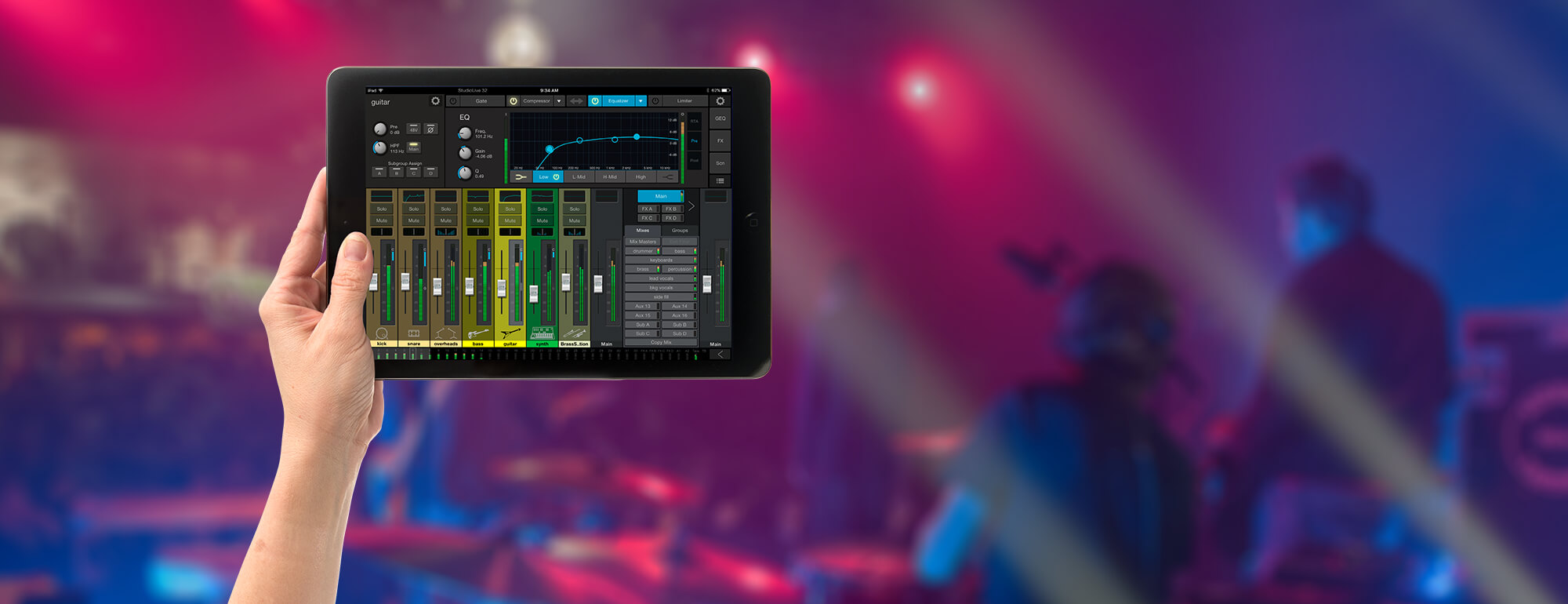This product has been discontinued.
Only with StudioLive AI.
StudioLive® AI Active Integration mixing consoles combine a familiar, analog-like mixing surface with the power of digital mixing. Easier to use, better sounding, and flawlessly integrated with state-of-the-art software, they deliver the most creative environment possible for both live performance and studio music production. Loaded with no-compromises signal processing on every channel, easy store and recall of every setting, high-end converters and preamps, and an integrated multitrack recording interface, StudioLive AI mixers are expandable and boast advanced networking capabilities unmatched in their price class. Yet they operate so much like an analog mixer that you’ll immediately feel at home.
The ease of analog meets the power of digital.
When you’re mixing a live event or have an artist in the studio, you need to be able to work quickly. The StudioLive AI’s familiar, easy-to-use interface keeps all critical controls visible and accessible —not buried in multiple menus or layers. Our design philosophy is simple: One fader for every channel, one output for every bus. This is the power of a surface-driven workflow. But don’t let the analog feel fool you: StudioLive AI mixers offer all of the features you expect in professional-class digital mixers and more.
You’ll never run out of signal processors.
StudioLive AI mixers provide more DSP power than any other mixer in their class. There are no limitations, no shared resources, no figuring out what processing is available where. You have all of the processing available at all times, with no compromises or caveats. The unique Fat Channel provides a compressor, limiter, expander/gate, and parametric EQ on every channel and bus; a highpass filter on each channel; a library of professionally crafted, useful presets; and the ability to save, selectively recall, and A/B-compare processor settings. You also get four effects processors, each with their own dedicated mix bus; a 31-band graphic EQ on every aux mix plus the mains; and 500 ms of delay available to each of the four subgroups.
Superior sound.
Connect a StudioLive AI mixer and you’ll instantly hear details and an open high end you’d expect to find only in an expensive studio console. StudioLive AI mixers operate at up to 96 kHz for high-definition mixing and recording. They use the same high-quality 64-bit summing engine found in our Studio One® DAW, which consistently receives rave reviews for sound quality. High-quality Burr-Brown converters on every input and output provide a best-in-class 118 dB of dynamic range so you’ll catch every high and low with great accuracy and no audible distortion. And our XMAX microphone preamps deliver incredibly high headroom, deep lows, smooth highs, and a rich overall sound.
Recording is in StudioLive AI’s DNA.
The StudioLive 32.4.2AI’s built-in 48x34 multitrack recording interface is tightly integrated with the rest of the mixer—not an afterthought we tacked on. All 32 channels, the tape inputs, and your choice of buses continuously stream to your FireWire- or Dante™-connected Mac or PC. Each channel can independently access its analog input or its dedicated digital return from your computer. And with StudioLive mixers, recording is simple and easy: Just launch the included, preconfigured Capture™ software for one-click recording of all channel inputs and your main mix. Or record with the included Studio One Artist DAW—or any recording software that supports ASIO or Core Audio. Now you can record in the studio or at the gig with equal ease—only with StudioLive.
Integrated, multiplatform software for flexible control and one-click recording.
Only PreSonus StudioLive AI mixers are tightly integrated with an entire suite of state-of-the-art software. Mix wirelessly or over a wired network from anywhere using UC Surface for Mac®, Windows®, and iPad®. Musicians control their monitor mixes onstage with QMix®-UC for iPhone®/iPod® touch and Android™ devices. Completely automate virtual soundchecks and record shows at up to 96 kHz with Capture™. Tune your system to the room and watch for problems in your mix with UC Surface’s integrated Smaart® wizards, RTA, and spectrograph. Save mixer scenes with your live recordings in Capture and edit both in Studio One Artist. Only StudioLive AI-series mixers and software work together to form a cohesive ecosystem that helps you achieve your creative vision.
Dedicated analog connections for predictable signal flow.
Take a look at back panel of a StudioLive AI-series mixer, and you’ll find the robust analog connections you’d expect from an expensive analog mixer: separate balanced mic and line inputs and insert points on every channel; dedicated balanced outputs for every aux bus, subgroup, and the mains; and a wealth of other dedicated inputs and outputs. Every input channel and bus send has its own dedicated jack—no sharing, no compromises—so you always know what’s flowing from each output.

Networking provides wireless control and eliminates snakes.
StudioLive Active Integration mixers make creating a wired or wireless network as easy as connecting an Ethernet cable or scrolling through a list of available wireless networks. Control your StudioLive AI mixer from anywhere in the venue using an iPad. Wirelessly control monitors from an iPhone or Android device. With the optional Dante card, a single Ethernet cable can send and receive networked audio for multitrack recording, remote control, and connecting to hundreds of Dante enabled products such as loudspeakers, stage boxes, and more. Use optional AVB to add a StudioLive RM-series Active Integration mixer as a stage box and monitor mixer, replacing bulky analog snakes with CAT5e. Go wireless, wired, or both. Once you’ve used a networked StudioLive AI console, you’ll never go back to the old way of mixing!
Configurable, flexible, and expandable.
Only StudioLive Active Integration mixers let you create a large-format console on a small-format budget. Start with 16, 24, or 32 channels, then cascade a second StudioLive AI-series mixer of any frame size to create custom-sized mixing consoles with all the hardware and software advantages of StudioLive Active Integration systems. Now your system can grow with your needs and budget!






















